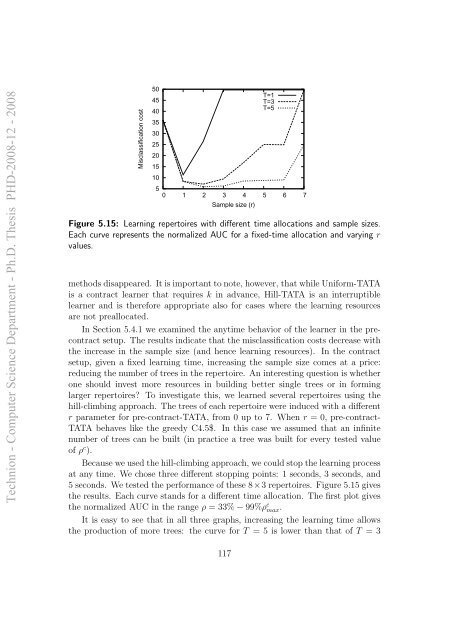anytime algorithms for learning anytime classifiers saher ... - Technion
anytime algorithms for learning anytime classifiers saher ... - Technion
anytime algorithms for learning anytime classifiers saher ... - Technion
You also want an ePaper? Increase the reach of your titles
YUMPU automatically turns print PDFs into web optimized ePapers that Google loves.
<strong>Technion</strong> - Computer Science Department - Ph.D. Thesis PHD-2008-12 - 2008<br />
Misclassification cost<br />
50<br />
45<br />
40<br />
35<br />
30<br />
25<br />
20<br />
15<br />
10<br />
5<br />
0 1 2 3 4 5 6 7<br />
Sample size (r)<br />
Figure 5.15: Learning repertoires with different time allocations and sample sizes.<br />
Each curve represents the normalized AUC <strong>for</strong> a fixed-time allocation and varying r<br />
values.<br />
methods disappeared. It is important to note, however, that while Uni<strong>for</strong>m-TATA<br />
is a contract learner that requires k in advance, Hill-TATA is an interruptible<br />
learner and is there<strong>for</strong>e appropriate also <strong>for</strong> cases where the <strong>learning</strong> resources<br />
are not preallocated.<br />
In Section 5.4.1 we examined the <strong>anytime</strong> behavior of the learner in the precontract<br />
setup. The results indicate that the misclassification costs decrease with<br />
the increase in the sample size (and hence <strong>learning</strong> resources). In the contract<br />
setup, given a fixed <strong>learning</strong> time, increasing the sample size comes at a price:<br />
reducing the number of trees in the repertoire. An interesting question is whether<br />
one should invest more resources in building better single trees or in <strong>for</strong>ming<br />
larger repertoires? To investigate this, we learned several repertoires using the<br />
hill-climbing approach. The trees of each repertoire were induced with a different<br />
r parameter <strong>for</strong> pre-contract-TATA, from 0 up to 7. When r = 0, pre-contract-<br />
TATA behaves like the greedy C4.5$. In this case we assumed that an infinite<br />
number of trees can be built (in practice a tree was built <strong>for</strong> every tested value<br />
of ρ c ).<br />
Because we used the hill-climbing approach, we could stop the <strong>learning</strong> process<br />
at any time. We chose three different stopping points: 1 seconds, 3 seconds, and<br />
5 seconds. We tested the per<strong>for</strong>mance of these 8×3 repertoires. Figure 5.15 gives<br />
the results. Each curve stands <strong>for</strong> a different time allocation. The first plot gives<br />
the normalized AUC in the range ρ = 33% − 99%ρ c max .<br />
It is easy to see that in all three graphs, increasing the <strong>learning</strong> time allows<br />
the production of more trees: the curve <strong>for</strong> T = 5 is lower than that of T = 3<br />
117<br />
T=1<br />
T=3<br />
T=5











